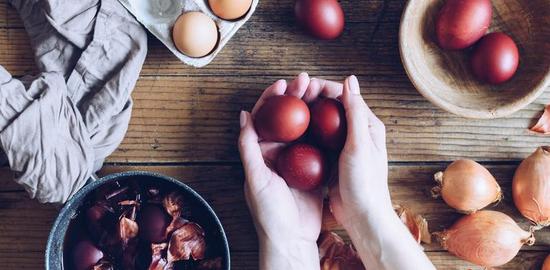Greece is known the world over for its cuisine which effortlessly combines Mediterranean ingredients with an Oriental spice palette. However, no matter how well-versed you may be in Greek cuisine, there are a few traditional dishes that you can only experience around Easter. Regardless of religious denomination, these dishes have superseded their origins and cemented their place to Greek traditions and are nowadays considered inexorably tied to the country's culture as expressed through food. Let us embark together on a culinary journey to the Easter delicacies of Greece!

Dying red eggs
If you could only pick one food that will immediately bring Easter into every Greek's mind, it is the red eggs. Traditionally dyed on Maundy Thursday and served in the coming days, the purpose of the red eggs is shrouded in somewhat of a mystery, as conflicting reasons for their symbolism range from the jovial and life-affirming to the macabre. However, one thing is certain; if there is one tradition that is present in every Easter Sunday meal, it is the tsougrisma. It wouldn't be an exaggeration to claim that tsougrisma has developed into something like a friendly sport among Greeks during Easter. The goal is to use your egg to break your opponent's and of course celebrate by eating the spoils afterwards! If you are ever to prepare these at home, we recommend avoiding the store-bought dyes and doing it the traditional way; by boiling the eggs with red onion peels for a more rustic feel.

Baking Koulouria
Every Greek has childhood memories of waking up to the smell of Paschalina Koulouria baking in the oven in preparation for the Holy Week festivities. These bites of sweet deliciousness will be the treat for every guest that visits your home in the following weeks and they are ideal to accompany a cup of coffee. Although there are many different ways to make them, the more traditional ones include a hint of Masticha -a quintessentially Greek ingredient- and honey. Nowadays you may find them in different shapes, but the original koulouria where shaped into braids, because it was believed to ward off evil spirits. These superstitions may have departed from the zeitgeist of Greek society, but the koulouria are thankfully here to stay!

Baking Tsoureki
If you have ever visited Greece and explored its cuisine, you may have noticed that Greeks have an unusual love for bread. Sure, it is one of the most common foods eaten worldwide, but the sheer number of types of bread that can be found in Greece, boggles the mind. Consequently, Easter in Greece also has its own type of sweet bread in the form of tsoureki. This type of bread is said to have originated in the Kingdom of Armenia and made its way through the Middle East, to the Greek cuisine in subsequent centuries. The main ingredient of a traditional tsoureki, mahlepi, betrays its origins as this spice is extracted from the seeds of a species of cherry endemic to the region of Mesopotamia. The Easter version is braided in shape (for the same reason as the koulouria) and is decorated with eggs dyed red.

Preparing Mageiritsa
We know what you are going to going to say but hear us out first! Admittedly mageiritsa is somewhat of an acquired taste, as a stew made of intestines rarely sounds appealing. However, if you give it a chance, mageiritsa might win you over and become your favorite Easter delicacy! This meal is only served during Holy Saturday and the history behind the establishment of mageiritsa as a staple of Greek Easter cuisine is both practical and brilliant. Historically, what preceded the Holy Week for believers was a long period of lent, during which a person's diet would be restricted to a handful of food groups. Mageiritsa is not only a way to utilize lamb scraps that will not make their way into the Easter Sunday lunch, but more importantly acts as a way to prepare your system for the grilled meat of the following day. Think of the highly nutritious mageiritsa as the perfect intermediate for transitioning from an austere diet to a hearty meal in the smoothest way possible. It suddenly doesn't sound too bad, right?

Lamb in souvla
...and here we are! The main course of the Easter celebrations! The feast to end all feasts! The lamb in souvla! In every corner of Greece you would be hard-pressed to find a different meal on Easter Sunday -if you were inexplicably inclined to do so in the first place. Although lamb is an important and frequently used part of Greek cuisine, the reason for its prevalence on Easter Sunday is tied to the Hebrew Passover. The Greek twist of preparing it in souvla (a large metal skewer) comes from the shepherds of Central Greece during the Ottoman occupation. Stranded in the mountains for long periods of time with their flock, the shepherds needed an innovative way of preparing a meal using the abundance of lambs they possessed, without the comforts of a kitchen. The results were subsequently tied to the Greek War of Independence and have permeated the Greek customs ever since!





